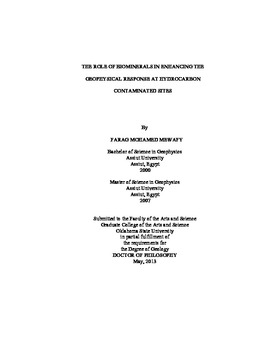| dc.contributor.advisor | Atekwana, Estella A. | |
| dc.contributor.author | Mewafy, Farag Mohamed | |
| dc.date.accessioned | 2014-09-24T14:16:36Z | |
| dc.date.available | 2014-09-24T14:16:36Z | |
| dc.date.issued | 2013-05 | |
| dc.identifier.uri | https://hdl.handle.net/11244/10975 | |
| dc.description.abstract | There are several source mechanisms by which microbial activity in the subsurface can change geophysical signatures. To date the source mechanisms generating the geophysical signatures in microbially active environments remain poorly understood. In this study, we investigated the link between the biogeochemical processes resulting in biotransformation of metallic iron mineral phases and the associated biogeophysical signatures. Hydrocarbon contaminated environments provide excellent laboratories for investigating iron mineral biotransformation. In particular, we investigated the magnetic susceptibility (MS) and the complex conductivity (CC) signatures of a hydrocarbon contaminated site near Bemidji, Minnesota. | |
| dc.description.abstract | For the MS study, we investigated the changes in the MS response for cores retrieved from the site as well as down boreholes. The contaminated location revealed two enriched MS zones. The first MS lies within the hydrocarbon smear zone, which is limited to the zone of water table fluctuation with high concentrations of dissolved Fe(II) and organic carbon content. Magnetite and siderite were the dominant minerals formed during this process. However, magnetite was responsible for the bulk of MS changes. The second zone of MS enhancement lies within the vadose zone which is characterized by methane depletion suggesting that aerobic or anaerobic oxidation of methane is coupled to iron-reduction resulting in magnetite precipitation. | |
| dc.description.abstract | For the CC work, we conducted laboratory CC measurements along four cores in addition to field CC survey. We found that the real (sigma') and imaginary (sigma'') conductivity are higher for samples from within the oil plume especially within the smear zone compared to background uncontaminated samples. Using magnetite as an example of the biometallic minerals in the smear zone at the site, a clear increase in the sigma'' response with increasing magnetite content was observed suggesting that the presence of bio-metallic mineral phases as well as electroactive Fe(II) within the smear zone impacts the imaginary conductivity. | |
| dc.description.abstract | Our results suggest that the biogeochemical processes leading to the precipitation of metallic iron mineral phases impacts the geophysical signatures at hydrocarbon contaminated sites undergoing active biodegradation. These bio-metallic minerals (e.g., magnetite) provide us with another source mechanism which has not been considered in previous studies. Therefore, the recognition of the zone of enriched bio-metallic iron mineral phases within the water table fluctuating zone calls for a reevaluation of biogeophysical signatures observed at hydrocarbon contaminated sites commonly attributed to an enhancement of pore water conductivity related to the production of metabolic byproducts. | |
| dc.format | application/pdf | |
| dc.language | en_US | |
| dc.rights | Copyright is held by the author who has granted the Oklahoma State University Library the non-exclusive right to share this material in its institutional repository. Contact Digital Library Services at lib-dls@okstate.edu or 405-744-9161 for the permission policy on the use, reproduction or distribution of this material. | |
| dc.title | Role of biominerals in enhancing the geophysical response at hydrocarbon contaminated sites | |
| dc.contributor.committeeMember | Puckette, James O. | |
| dc.contributor.committeeMember | Jaiswal, Priyank | |
| dc.contributor.committeeMember | Lao-Davila, Daniel Alberto | |
| dc.contributor.committeeMember | Fathepure, Babu Z. | |
| osu.filename | Mewafy_okstate_0664D_12796.pdf | |
| osu.accesstype | Open Access | |
| dc.type.genre | Dissertation | |
| dc.type.material | Text | |
| thesis.degree.discipline | Geology | |
| thesis.degree.grantor | Oklahoma State University | |
